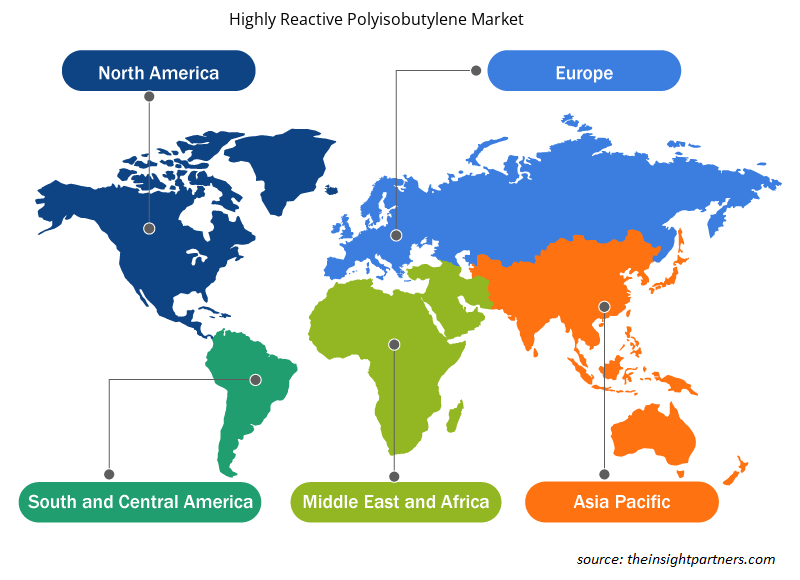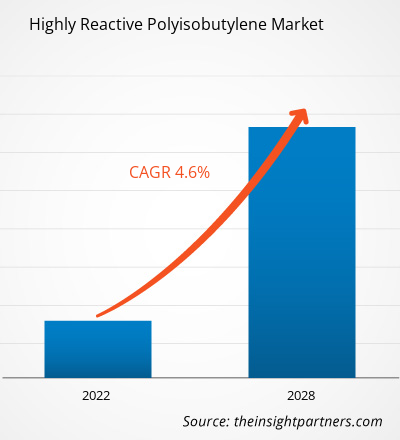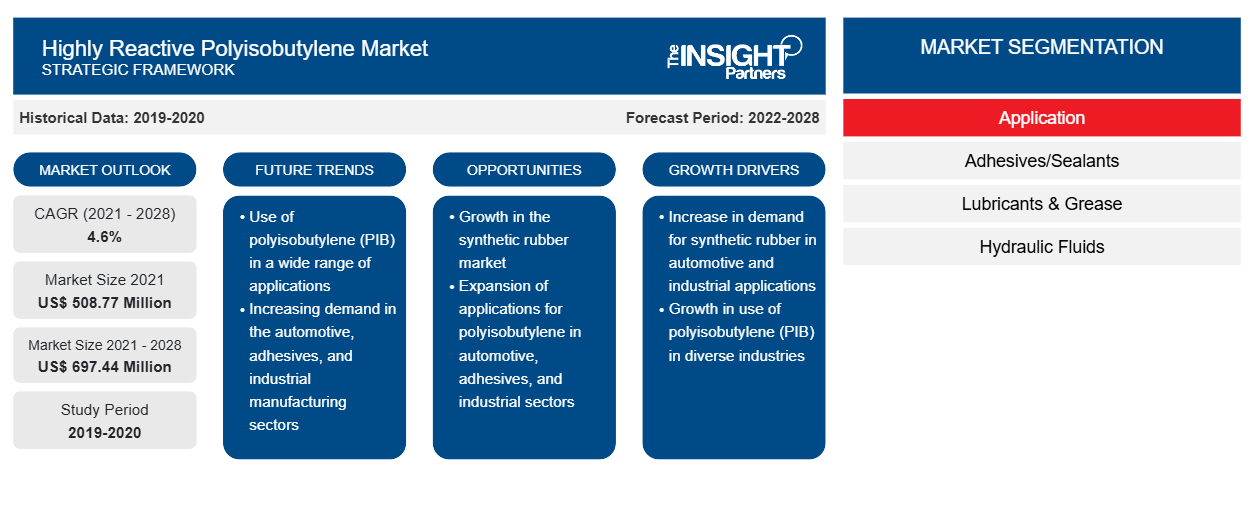Si prevede che il mercato del poliisobutilene altamente reattivo raggiungerà i 697,44 milioni di dollari entro il 2028, rispetto ai 508,77 milioni di dollari del 2021; si prevede che crescerà a un CAGR del 4,6% dal 2021 al 2028.
Il poliisobutilene altamente reattivo (HR-PIB) è un importante intermedio utilizzato nella produzione di additivi per carburanti e lubrificanti ad alte prestazioni, come disperdenti per oli motore o detergenti per carburanti. Gli additivi per lubrificanti ad alte prestazioni consentono progetti di motori più efficienti in termini di consumo di carburante.
Nel 2020, l'Asia Pacifica ha detenuto la quota di fatturato maggiore del mercato del poliisobutilene altamente reattivo . Il segmento dei lubrificanti e dei grassi è il maggiore consumatore di HR-PIB nella regione Asia Pacifica. La proliferazione del settore automobilistico nella regione sta aumentando la domanda di fluidi idraulici e lubrificanti, spingendo così la necessità di HR-PIB. Inoltre, l'aumento dell'industrializzazione e dell'edilizia nell'Asia Pacifica sta guidando la domanda di macchinari e attrezzature nelle strutture di produzione correlate.
Personalizza questo report in base alle tue esigenze
Riceverai la personalizzazione gratuita di qualsiasi report, comprese parti di questo report, o analisi a livello nazionale, pacchetto dati Excel, oltre a usufruire di grandi offerte e sconti per start-up e università
-
Scopri le principali tendenze di mercato in questo rapporto.Questo campione GRATUITO includerà analisi di dati che spaziano dalle tendenze di mercato alle stime e alle previsioni.
Impatto della pandemia di COVID-19 sul mercato del poliisobutilene altamente reattivo
Nel 2020, vari settori hanno dovuto rallentare le proprie attività a causa di interruzioni nelle catene di fornitura causate dalla chiusura dei confini nazionali e internazionali, che hanno portato a una bassa domanda di HR-PIB. La pandemia ha causato interruzioni nei processi di produzione a causa delle restrizioni imposte dalle autorità governative in vari paesi sul personale nei reparti di lavoro e sui trasporti, il che ha reso difficile per i dipendenti spostarsi da e verso i luoghi di lavoro. HR-PIB trova importanti applicazioni nella produzione di additivi per carburanti e lubrificanti ad alte prestazioni. La diminuzione della domanda di carburante da parte di vari settori ha ostacolato il consumo di additivi per carburanti, ostacolando infine le vendite di HR-PIB. Tuttavia, quando le economie hanno iniziato a rilanciare le proprie attività nel 2021, anche la domanda di HR-PIB ha iniziato a crescere gradualmente.
Approfondimenti di mercato
Utilizzo crescente di HR-PIB nella produzione di additivi per carburanti e lubrificanti ad alte prestazioni
L'HR-PIB è un importante intermedio che trova applicazione nella produzione di is an important intermediate that finds application in the production of high-performance fuel and additivi per carburanti e lubrificanti ad alte prestazioni . Grazie alla sua natura altamente reattiva, è preferito al poliisobutilene convenzionale nella produzione di additivi. La funzione principale degli additivi per lubrificanti è quella di migliorare le proprietà della base in diverse condizioni operative. Inoltre, gli additivi per lubrificanti ad alte prestazioni supportano progetti di motori più efficienti in termini di carburante. I disperdenti sono additivi per lubrificanti che aiutano a prevenire la formazione di fanghi, vernici e altri depositi su superfici critiche. La domanda di HR-PIB sta crescendo nella sintesi industriale di disperdenti per oli motore per autoveicoli. La presenza di solide basi di produzione di additivi negli Stati Uniti, in Europa e nell'Asia Pacifica li rende i principali consumatori di HR-PIB. Quindi, il crescente utilizzo di HR-PIB nella produzione di additivi per carburanti e lubrificanti ad alte prestazioni stimola la crescita del mercato.polyisobutylene in the production of additives. The main function of lubricant additives is to improve the properties of the base stock under different operating conditions. Moreover, high-performance lubricant additives support more fuel-efficient engine designs. Dispersants are lubricant additives that help prevent sludge, varnish, and other deposit formation on critical surfaces. The demand for HR-PIB is growing in the industrial synthesis of dispersants for automotive engine oils. The presence of strong additive manufacturing bases in the US, Europe, and Asia Pacific makes them prime consumers of HR-PIB. Hence, the increasing use of HR-PIB in the manufacturing of high-performance fuel and lubricant additives boosts the market growth.
Approfondimenti sulle applicazioni
In base all'applicazione, il mercato del poliisobutilene altamente reattivo è stato segmentato in adesivi/sigillanti, lubrificanti e grassi, fluidi idraulici, fluidi per la lavorazione dei metalli e altri. Il segmento dei lubrificanti e dei grassi ha detenuto la quota di mercato maggiore nel 2020. Lubrificanti come oli motore, oli per trasmissioni, oli per ingranaggi, grassi e oli per compressori sono ampiamente consumati nei settori automobilistico, aeronautico, marittimo e dei macchinari. HR-PIB aiuta a migliorare le prestazioni complessive dei lubrificanti.polyisobutylene market has been segmented into adhesives/sealants, lubricants & grease, hydraulic fluids, metal working fluids, and others. The lubricants & grease segment held the largest market share in 2020. Lubricants such as engine oils, transmission oils, gear oils, greases, and compressor oils are highly consumed in the automotive, aircraft, marine, and machinery industries. HR-PIB helps enhance the overall performance of lubricants.
TPC Group; RB PRODUCTS INC.; BASF PETRONAS Chemicals Sdn. Bhd; Shandong Hongrui New Material Technology Co., Ltd; Daelim Co., Ltd.; Chevron Corporation; The Lubrizol Corporation; KEMAT Polybutenes; Weifang Binhai Petro-chem Co., Ltd.; e Nelson Brothers Incorporated sono tra i principali attori del mercato del poliisobutilene altamente reattivo. Gli attori che operano nel mercato del poliisobutilene altamente reattivo sono fortemente concentrati sullo sviluppo di prodotti innovativi e di alta qualità per soddisfare i requisiti del cliente. Group; RB PRODUCTS INC.; BASF PETRONAS Chemicals Sdn. Bhd; Shandong Hongrui New Material Technology Co., Ltd; Daelim Co., Ltd.; Chevron Corporation; The Lubrizol Corporation; KEMAT Polybutenes; Weifang Binhai Petro-chem Co., Ltd.; and Nelson Brothers Incorporated are among the key market players in the highly reactive polyisobutylene market. Players operating in the highly reactive polyisobutylene market are highly focused on the development of high-quality and innovative products to meet the customer’s requirements.
Approfondimenti regionali sul mercato del poliisobutilene altamente reattivoPolyisobutylene Market Regional Insights
Le tendenze regionali e i fattori che influenzano il mercato del poliisobutilene altamente reattivo durante il periodo di previsione sono stati ampiamente spiegati dagli analisti di Insight Partners. Questa sezione discute anche i segmenti del mercato del poliisobutilene altamente reattivo e la geografia in Nord America, Europa, Asia Pacifico, Medio Oriente e Africa e America meridionale e centrale.

- Ottieni i dati specifici regionali per il mercato del poliisobutilene altamente reattivo
Ambito del rapporto di mercato del poliisobutilene altamente reattivo
| Attributo del report | Dettagli |
|---|---|
| Dimensioni del mercato nel 2021 | 508,77 milioni di dollari USA |
| Dimensioni del mercato entro il 2028 | 697,44 milioni di dollari USA |
| CAGR globale (2021 - 2028) | 4,6% |
| Dati storici | 2019-2020 |
| Periodo di previsione | 2022-2028 |
| Segmenti coperti |
Per applicazione
|
| Regioni e Paesi coperti |
America del Nord
|
| Leader di mercato e profili aziendali chiave |
|
Densità degli attori del mercato del poliisobutilene altamente reattivo: comprendere il suo impatto sulle dinamiche aziendali
Il mercato del poliisobutilene altamente reattivo sta crescendo rapidamente, spinto dalla crescente domanda degli utenti finali dovuta a fattori quali l'evoluzione delle preferenze dei consumatori, i progressi tecnologici e una maggiore consapevolezza dei vantaggi del prodotto. Con l'aumento della domanda, le aziende stanno ampliando le loro offerte, innovando per soddisfare le esigenze dei consumatori e capitalizzando sulle tendenze emergenti, il che alimenta ulteriormente la crescita del mercato.
La densità degli operatori di mercato si riferisce alla distribuzione di aziende o società che operano in un particolare mercato o settore. Indica quanti concorrenti (operatori di mercato) sono presenti in un dato spazio di mercato in relazione alle sue dimensioni o al valore di mercato totale.
Le principali aziende che operano nel mercato del poliisobutilene altamente reattivo sono:
- Gruppo TPC
- PRODOTTI RB INC.
- Società chimica BASF PETRONAS S.p.A.
- Shandong Hongrui New Material Technology Co., Ltd
- Società anonima Daelim Co., Ltd.
Disclaimer : le aziende elencate sopra non sono classificate secondo un ordine particolare.

- Ottieni una panoramica dei principali attori del mercato del poliisobutilene altamente reattivo
Segnala i riflettori
- Tendenze progressive nel settore del poliisobutilene altamente reattivo per aiutare gli operatori a sviluppare strategie efficaci a lungo termine
- Strategie di crescita aziendale adottate dalle aziende per garantire la crescita nei mercati sviluppati e in via di sviluppo
- Analisi quantitativa del mercato del poliisobutilene altamente reattivo dal 2019 al 2028
- Stima della domanda globale di HR-PIB
- Analisi delle cinque forze di Porter per illustrare l'efficacia degli acquirenti e dei fornitori che operano nel settore
- Sviluppi recenti per comprendere lo scenario competitivo del mercato
- Tendenze e prospettive di mercato, e fattori che guidano e frenano la crescita del mercato del poliisobutilene altamente reattivo
- Assistenza nel processo decisionale evidenziando le strategie di mercato che sostengono l'interesse commerciale
- Dimensioni del mercato del poliisobutilene altamente reattivo in vari nodi
- Panoramica dettagliata e segmentazione del mercato e dinamiche del settore HR-PIB
- Dimensioni del mercato del poliisobutilene altamente reattivo in varie regioni con promettenti opportunità di crescita
Mercato del poliisobutilene altamente reattivo
Applicazione
- Adesivi/Sigillanti
- Lubrificante e grasso
- Fluidi idraulici
- Fluidi per la lavorazione dei metalli
- Altri
Profili aziendali
- Gruppo TPC
- PRODOTTI RB INC.
- Società chimica BASF PETRONAS S.p.A.
- Shandong Hongrui New Material Technology Co., Ltd
- Società anonima Daelim Co., Ltd.
- Società Chevron
- La società Lubrizol
- Polibuteni KEMAT
- Società per azioni Weifang Binhai Petro-chem Co., Ltd.
- Fratelli Nelson Incorporated
- Analisi storica (2 anni), anno base, previsione (7 anni) con CAGR
- Analisi PEST e SWOT
- Valore/volume delle dimensioni del mercato - Globale, Regionale, Nazionale
- Industria e panorama competitivo
- Set di dati Excel
Report recenti
Testimonianze
Motivo dell'acquisto
- Processo decisionale informato
- Comprensione delle dinamiche di mercato
- Analisi competitiva
- Analisi dei clienti
- Previsioni di mercato
- Mitigazione del rischio
- Pianificazione strategica
- Giustificazione degli investimenti
- Identificazione dei mercati emergenti
- Miglioramento delle strategie di marketing
- Aumento dell'efficienza operativa
- Allineamento alle tendenze normative























 Ottieni un campione gratuito per - Mercato del poliisobutilene altamente reattivo
Ottieni un campione gratuito per - Mercato del poliisobutilene altamente reattivo